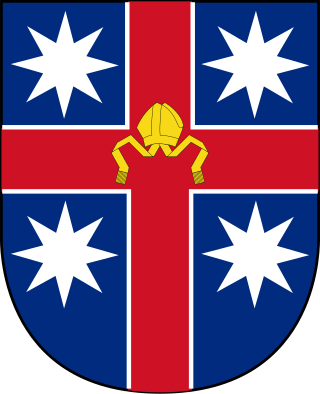Related Research Articles

Peter John Hollingworth, is an Australian retired Anglican bishop. Engaged in social work for several decades, he served as the archbishop of the Anglican Diocese of Brisbane in Queensland for 11 years from 1989 and was the 1991 Australian of the Year. He served as the 23rd governor-general of Australia from 2001 until 2003. He is also an author and recipient of various civil and ecclesiastical honours. In May 2003 Hollingworth became the third Australian governor-general to resign, after criticisms were aired over his conduct as Anglican Archbishop of Brisbane in the 1990s.

The Anglican Church of Australia, formerly known as the Church of England in Australia and Tasmania, is a Christian church in Australia and an autonomous church of the Anglican Communion. It is the second largest church in Australia after the Catholic Church. According to the 2016 census, 3.1 million Australians identify as Anglicans. As of 2016, the Anglican Church of Australia had more than 3 million nominal members and 437,880 active baptised members. For much of Australian history since the arrival of the First Fleet in January 1788, the church was the largest religious denomination. It remains today one of the largest providers of social welfare services in Australia.
Lynn Maurice Ferguson Arnold, AO is an Anglican priest and a former Australian politician, who represented the South Australian Branch of the Australian Labor Party, serving as Premier of South Australia between 4 September 1992 and 14 December 1993, during the 11 years of Labor government which ended in a landslide defeat of his government at the 1993 election.

Phillip John Aspinall is an Australian Anglican bishop who served as Anglican Archbishop of Brisbane from February 2002 until December 2022, and was also the Primate of the Anglican Church of Australia from July 2005 until he stood down on 4 July 2014.

The Ngunnawal people, also spelt Ngunawal, are an Aboriginal people of southern New South Wales and the Australian Capital Territory in Australia.

Affordable housing is housing which is deemed affordable to those with a household income at or below the median as rated by the national government or a local government by a recognized housing affordability index. Most of the literature on affordable housing refers to mortgages and a number of forms that exist along a continuum – from emergency homeless shelters, to transitional housing, to non-market rental, to formal and informal rental, indigenous housing, and ending with affordable home ownership.

The Australian Council of Social Service (ACOSS) is an Australian organisation that advocates for action to reduce poverty and inequality, and is the peak body for the community services sector in Australia. It was formed in 1956.

Homelessness in Australia is a social issue concerning the number of people in Australia that are considered to be homeless. There are no internationally agreed upon definitions of homelessness, making it difficult to compare levels of homelessness across countries. A majority of people experiencing homelessness long-term in Australia are found in the large cities of Sydney, Melbourne, Brisbane and Perth. It is estimated that on any given night approximately 116,000 people will be homeless and many more are living in insecure housing, "one step away from being homeless". A person who does not obtain any shelter is often described as sleeping 'rough'.

The Anglican Diocese of Tasmania includes the entire Tasmanian state of Australia and is an extraprovincial diocese of the Anglican Church of Australia.

Poverty in the United Kingdom is the condition experienced by the portion of the population of the United Kingdom that lacks adequate financial resources for a certain standard of living, as defined under the various measures of poverty.

Public housing in Australia is one part of social housing and the other is community housing. Public housing is provided by departments of state governments. Australian public housing operates within the framework of the Commonwealth-State Housing Agreement, by which funding for public and community housing is provided by both federal and state governments. According to the 2006 census, Australia's public housing stock consisted of some 304,000 dwellings out of a total housing stock of more than 7.1 million dwellings, or 4.2% of all housing stock.

Home ownership in Australia is considered a key cultural icon, and part of the Australian tradition known as the Great Australian Dream of "owning a detached house on a fenced block of land." Home ownership has been seen as creating a responsible citizenry; according to a former Premier of Victoria: "The home owner feels that he has a stake in the country, and that he has something worth working for, living for, fighting for."

In the United States, subsidized housing is administered by federal, state and local agencies to provide subsidized rental assistance for low-income households. Public housing is priced much below the market rate, allowing people to live in more convenient locations rather than move away from the city in search of lower rents. In most federally-funded rental assistance programs, the tenants' monthly rent is set at 30% of their household income. Now increasingly provided in a variety of settings and formats, originally public housing in the U.S. consisted primarily of one or more concentrated blocks of low-rise and/or high-rise apartment buildings. These complexes are operated by state and local housing authorities which are authorized and funded by the United States Department of Housing and Urban Development (HUD). In 2020, there were one million public housing units. In 2022, about 5.2 million American households that received some form of federal rental assistance.

The Australian property market comprises the trade of land and its permanent fixtures located within Australia. The average Australian property price grew 0.5% per year from 1890 to 1990 after inflation, however rose from 1990 to 2017 at a faster rate. House prices in Australia receive considerable attention from the media and the Reserve Bank and some commentators have argued that there is an Australian property bubble.
Jeffrey William Driver is a retired Australian Anglican bishop. He is the former Archbishop of Adelaide and Metropolitan of South Australia in the Anglican Church of Australia.
Garry John Weatherill is the current Anglican Bishop of Ballarat in the Province of Victoria, Australia. He was previously the sixth Bishop of Willochra (2000–2011).
The Australian Housing and Urban Research Institute (AHURI) is a national not-for-profit independent network organization that funds, conducts, disseminates, and tailors research on housing, homelessness, cities and urban policy. The organisation's funding is received from the Australian Government, state and territory governments, as well as contributions from partner universities. As the only organisation in Australia dedicated exclusively to housing, homelessness, cities and related urban research, AHURI is a unique venture. Through its national network of university partners, AHURI undertakes research that supports policy development at all levels of government, assists industry in improving practice and informs the broader community. In 2022, AHURI had nine research partners across Australia.
Karen Kime is an Aboriginal Australian priest and archdeacon in the Anglican Church of Australia. She is a Birripi woman.
Christopher Randall Jones is an Australian bishop in the Anglican Church of Australia. He has served as an assistant bishop and vicar-general in the Anglican Diocese of Tasmania since February 2008. He has also been the CEO of Anglicare Tasmania since 1988.

Housing in the United States comes in a variety of forms and tenures. The rate of homeownership in the United States, as measured by the fraction of units that are owner-occupied, was 64% as of 2017. This rate is less than the rates in other large countries such as China (90%), Russia (89%) Mexico (80%), or Brazil (73%).
References
- ↑ Anglicare Australia, State of the Family report, ISSN 1832-5564 online ISSN 1822-931X
- ↑ State of the Family 2001 State of the Family Report 2001 - Economic and Social Exclusion, Dr Ann Nevile
- ↑ State of the Family Report 2002 - Unemployment and Poverty, Dr Ann Nevile
- ↑ State of the Family Report 2003 - Children growing up in Poverty, Dr Ann Neville
- ↑ State of the Family Report 2004 - Missing out: Youth in Australia today, Mark Jeffery
- ↑ State of the Family Report 2005 - What do Australian Families look like today?
- ↑ State of the Family Report 2006 - Life on a Low Income
- ↑ State of the Family Report 2008 - Creative Tension: Australia's Social Inclusion Agenda
- ↑ State of the Family Report 2009 - Beyond Economics - families in the forefront
- ↑ Stephen Lunn, (12 October 2009), Therese Rein fights for those sideswiped by slump, The Australian
- ↑ John Ferguson, (12 October 2009), Families struggle with food, bills - seek aid, Herald Sun
- ↑ State of the Family Report 2010 - In From the Edge
- ↑ State of the Family Report 2012 - Staying Power
- ↑ State of the Family Report 2012 - When there’s not enough to eat
- ↑ When there’s not enough to eat Volume 1
- ↑ State of the Family Report 2012 - When there’s not enough to eat Volume 2
- ↑ Anglicare Australia, (13 October 2013), Media release: Paying Attention, Anglicare Australia, Canberra, Australia. 2013. State of the Family report 2013: Paying Attention, Anglicare Australia: Canberra.
- ↑ Anglicare Australia, (14 October 2014), Media release: Youth support a circuit breaker, Anglicare Australia, Canberra, Anglicare Australia. 2014. State of the Family report 2014: Being a/part., Anglicare Australia: Canberra.
- ↑ Anglicare Australia, (12 October 2015), Media release: Do we care who's being left behind?, Anglicare Australia, Canberra, Anglicare Australia. 2015. State of the Family report: Who is being left behind?, Anglicare Australia: Canberra.
- ↑ Michael Edwards, (12 October 2015), New research shows most welfare recipients living in poverty, AM ABC Radio National
- ↑ Beth Doherty, (31 October 2016), Positions Vacant: When the Jobs Aren't There, Anglicare Australia, Canberra Anglicare Australia. 2016. Positions Vacant: When the Jobs Aren't There, Anglicare Australia: Canberra.
- ↑ Anglicare Australia, (21 April 2016), Media release Too many still locked out of affordable housing, Anglicare Australia, Canberra, Anglicare Australia, (April 2016), Rental Affordability Snapshot, Anglicare Australia, Canberra
- ↑ Emily Laurence, (21 April 2016), Rental market in Greater Sydney and Illawarra squeezing out those on government benefits, ABC
AAP, (21 April 2016), Poor parents 'locked out' of rental market, 9news, South Australia